

Why is the mudra so important? (c) Can Stock Photo / coffeekai “When one displays the buddha mudra with one’s whole body and mind, sitting upright in this samadhi even for a short time, everything in the entire dharma world becomes buddha mudra, and all space in the universe completely becomes enlightenment.”[1] Why is the mudra so important?
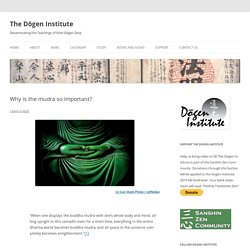
In this passage from Bendowa, Dōgen is describing what happens when we really practice what Buddha taught and what Nyojo Zenji taught – in other words, in dropping off body and mind, how does this world look? Dōgen is describing a paradigm shift, a completely different way of how things look. Buddhist philosophy. The Buddhist Nalanda university and monastery was a major center of learning in India from the 5th century CE until the 12th century.[1] Particular points of Buddhist philosophy have often been the subject of disputes between different schools of Buddhism.
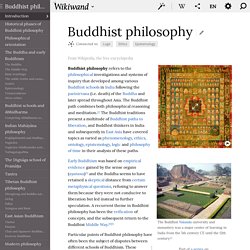
These elaborations and disputes gave rise to various schools in early Buddhism of Abhidharma, and to the Mahayana traditions such as Prajñāpāramitā, Madhyamaka, Buddha-nature and Yogācāra. WARSZAWSKA GRUPA SHAOLIŃSKIEGO QIGONG. (PDF) Dapsance - Thèse de doctorat en anthropologie - EPHE - Ceci n'est pas une religion. Institut Catholique de Paris - Academia.edu. (DOC) Quand la sagesse devient folle. Le bouddhisme tibétain en Occident entre mystique et mystification (texte entier)
Study of Dependent Arising, dependent origination. GODS of Japan, A-to-Z Photo Dictionary of Japanese Buddhist and Shinto Deities. PREFACE My reasons for creating this photo dictionary are quite simple.
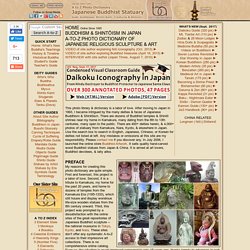
First and foremost, this project is a labor of love. Second, it is a tribute to Kamakura, my home for the past 20 years, and home to dozens of temples from the Kamakura Era (1185-1333), which still house and display wondrous life-size wooden statues from the 8th century onward. Third, this project was prompted by a dissatisfaction with the online sites of the great repositories of Japanese Buddhist sculpture -- the national museums in Tokyo, Kyoto, and Nara. These sites don’t offer any systematic A-to-Z access to their impressive art collections. There is no comprehensive online catalog. Fourth, this project was prompted by a dissatisfaction with existing literature on Japanese Buddhist statuary. Don’t get me wrong.
The study of Japanese religions and religious art has expanded greatly in the West over the past five decades. Miroir du Dharma. Les trois niveaux de la prise de refuge (RevuesDharma.D13A6) - XWiki. ExportPdf Gourou Padmasambhava « Pour chacun des mille bouddhas qui doivent apparaître durant notre ère, il y aura un Gourou Rinpoché pour mettre en œuvre ses activités.
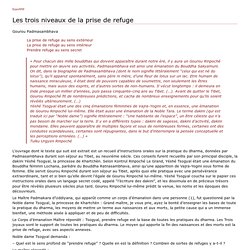
Padmasambhava est ainsi une émanation du Bouddha Sakyamuni. On dit, dans la biographie de Padmasambhava (dont le nom signifie littéralement “celui qui est né du lotus”), qu’il apparut spontanément, sans père ni mère, d’une fleur de lotus sur un lac. Etre humain de naissance miraculeuse, il était doté de pouvoirs capables de soumettre, non seulement les êtres humains, mais aussi des esprits, et d’autres sortes de non-humains. L’ouvrage dont le texte qui suit est extrait est un recueil d’instructions orales sur la pratique du dharma, données par Padmasambhava durant son séjour au Tibet, au neuvième siècle.
Le Corps d’émanation Maître répondit : Tsogyal, prendre refuge est la base de toutes les pratiques du dharma. Փ. SKC - Accueil. News and notes on the Tibetan non-monastic ordained tantric sangha. Dzogchen teachers in Kathmandu - Dharma Wheel. Amazon. Olmo Ling - Home Page. Tibetan Studies. Shams-i-bala and The Historical Shambhala Kingdom: Dzogchen: Fifteen Stages of A-Tri (A-Khrid) Meditation. Click Here to View the Dzogchen Explorations Index "A-Tri (A-Khrid), literally “The Guidance of the Primordial State” is one of the three principal Dzogchen (Great Perfection) traditions within Bön.
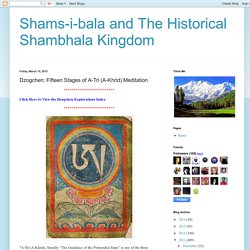
It was founded in the 11th century by Ritro Chenpo (1038-1096), known simply as “the holy man,” who systematized previous teachings and added his own mind-treasures to create a succession of eighty practices. These were later organized into thirty sessions and finally during the 13th century condensed into a practice manual of fifteen sessions by the renowned lama Drugyalwa Yungdrung. Over the next two years Tenzin Wangyal Rinpoche will offer comprehensive teachings and practice instruction from Drugyalwa’s text “The Fifteen Stages of Practice that Guide One to the Primordial State.” These stages begin with preliminary practices to ripen the consciousness and progress through practices to stabilize the mind and directly realize its true nature.
"..... Email....okarresearch@gmail.com J. Voyage initiatique, voyage spirituel en Inde et Asie. Dzogchen wiki. Les enseignements de la Grande Perfection (Dzogchen) présentent un très grand nombre de spécificités, à commencer par un vocabulaire philosophique et yogique très particulier, avec des nuances subtiles et des principes souvent à même d'égarer la compréhension des néophytes.

L'écueil le plus fréquent est celui de l'incapacité à différencier l'état de cette Grande Perfection — par définition pure et parfaite — de celui du pratiquant dzogchen — lui-même encore impur et imparfait jusqu'à l'obtention de l'Eveil. Ce sont donc essentiellement l'histoire, la littérature, les pratiques et le vocabulaire du Dzogchen qui forment l'objet du présent wiki.
The Single Golden Letter of the Black Quintessence in English, (yang ti nag po gser gyi ‘bru gcig) in Tibetan - Chinese Buddhist Encyclopedia. Yangti Nagpo Information by Sarah SchneiderDungtso Repa the Earlier, was a tertön in the thirteenth century in Tibet.

His reincarnation was Dungtso Repa the Later in the fifteenth century in Tibet. Dungtso Repa the Later became a disciple and then the consort of the female tertön, Kunga Bum. From among the treasures he revealed, three are most famous. The last of these was revealed in Lake Mandal Nagpo behind Dakpo Gampo Monastery. From this lake, Dungtso Repa discovered a treasure casket. Www.dharmawheel.net. Translations – Buddha Visions. The texts presented here and in the bookstore were translated with the support of sangha, family, and friends, under the guidance of very kind teachers.
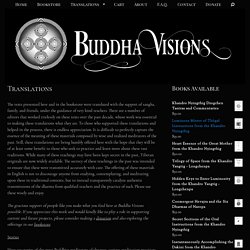
There are a number of editors that worked tirelessly on these texts over the past decade, whose work was essential to making these translations what they are. To those who supported these translations and helped in the process, there is endless appreciation. It is difficult to perfectly capture the essence of the meaning of these materials composed by wise and realized meditators of the past. Still, these translations are being humbly offered here with the hope that they will be of at least some benefit to those who seek to practice and learn more about these vast traditions. Namse Bangdzo Bookstore.
Tibeto-logic. Notes on Lamrim. Dans le sillage d'Advayavajra. The White-Robed, Dreadlocked Community: Dr Nida Chenagtsang’s Introduction to and Defense of the Ngakpa Tradition. The Treasury of Lives: A Biographical Encyclopedia of Tibet, Inner Asia and the Himalayan Region.